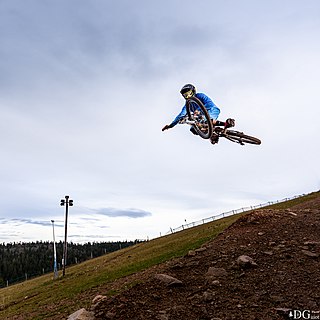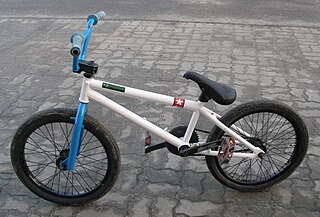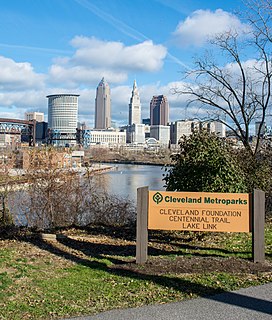Related Research Articles

A mountain bike (MTB) or mountain bicycle is a bicycle designed for off-road cycling. Mountain bikes share some similarities with other bicycles, but incorporate features designed to enhance durability and performance in rough terrain, which makes them heavier, more complex and less efficient on smooth surfaces. These typically include a suspension fork, large knobby tires, more durable wheels, more powerful brakes, straight, extra wide handlebars to improve balance and comfort over rough terrain, and wide-ratio gearing optimised for topography and application. Rear suspension is ubiquitous in heavier-duty bikes and now common even in lighter bikes. Dropper posts can be installed to allow the rider to quickly adjust the seat height.

Mountain biking is a sport of riding bicycles off-road, often over rough terrain, usually using specially designed mountain bikes. Mountain bikes share similarities with other bikes but incorporate features designed to enhance durability and performance in rough terrain, such as air or coil-sprung shocks used as suspension, larger and wider wheels and tires, stronger frame materials, and mechanically or hydraulically actuated disc brakes. Mountain biking can generally be broken down into five distinct categories: cross country, trail riding, all mountain, downhill, and freeride.

Thredbo is a village and ski resort in the Snowy Mountains of New South Wales, Australia, situated in a part of the Snowy Monaro Regional Council, and has been operated by Event Hospitality and Entertainment since 1987. It is about 500 kilometres (310 mi) south of Sydney, accessible by the Alpine Way via Cooma, Berridale, and Jindabyne. The village is built in the valley of the Thredbo River, also known as the Crackenback River, at the foot of the Ramshead Range.

Cycle sport is competitive physical activity using bicycles. There are several categories of bicycle racing including road bicycle racing, cyclo-cross, mountain bike racing, track cycling, BMX, and cycle speedway. Non-racing cycling sports include artistic cycling, cycle polo, freestyle BMX and mountain bike trials. The Union Cycliste Internationale (UCI) is the world governing body for cycling and international competitive cycling events. The International Human Powered Vehicle Association is the governing body for human-powered vehicles that imposes far fewer restrictions on their design than does the UCI. The UltraMarathon Cycling Association is the governing body for many ultra-distance cycling races.

Downhill mountain biking (DH) is a genre of mountain biking practiced on steep, rough terrain that often features jumps, drops, rock gardens and other obstacles. Jumps can be up to and including 12 meters, and drops can be greater than 3 meters.

Canada Olympic Park (COP), formerly known as Paskapoo Ski Hill, is a ski hill and multi-purpose training and competition facility located in Calgary, Alberta, Canada, owned and operated by WinSport. It is currently used both for high performance athletic training and for recreational purposes by the general public. Canada Olympic Park was one of the venues for the 1988 Winter Olympics, being the primary venue for ski jumping, bobsleigh, and luge.

Oak Mountain State Park is a publicly owned recreation area located approximately 20 miles (32 km) south of Birmingham in the northeast quadrant of the city of Pelham, Alabama, United States. It is the state's largest state park at 9,940 acres (4,020 ha) and is home to the Alabama Wildlife Center, Oak Mountain Interpretive Center, and Oak Mountain BMX Track. Park activities include hiking, running, mountain biking, swimming, camping, fishing, horseback riding, and golf. The park is managed by the Alabama Department of Conservation and Natural Resources.

Freestyle BMX is bicycle motocross stunt riding on BMX bikes. It is an extreme sport descended from BMX racing that consists of five disciplines: street, park, vert, trails, and flatland. In June 2017, the International Olympic Committee announced that freestyle park was to be added as an Olympic event to the 2020 Summer Olympics.

Freeride is a discipline of mountain biking closely related to downhill biking, dirt jumping, Freestyle motocross, and freestyle BMX. When riding a freerider one focuses on tricks, style, and technical trail features. Freeride is now recognized as one of the most popular disciplines within mountain biking.

Mountain bike racing is the competitive cycle sport discipline of mountain biking held on off-road terrain. The Union Cycliste Internationale (UCI) recognised the discipline relatively late in 1990, when it sanctioned the world championships in Durango, Colorado. The first UCI Mountain Bike World Cup series took place in 1988. Its nine-race circuit covered two continents—Europe and North America—and was sponsored by Grundig. Cross-country racing was the only World Cup sport at this time. In 1993, a six-event downhill World Cup was introduced. In 1996, cross-country mountain biking events were added to the Olympic Games. In 2006, cross-country mountain biking events became part of the World Deaf Cycling Championships for the first time in San Francisco, USA.

Dirt jumping is the practice of riding bikes over jumps made of dirt or soil and becoming airborne. Dirt Jumping evolved alongside BMX racing and is similar to BMX or mountain bike racing in that the rider jumps off of mounds of dirt, usually performing a midair trick in between. It differs in that the jumps are usually much larger and designed to lift the rider higher into the air. Additionally, the goal is not to complete the course with the fastest time, but rather to perform the tricks with the style. Dirt jumping can be performed on BMX bikes or specialized mountain bikes known simply as "dirt jumpers".

A downhill bike is a full suspension bicycle designed for downhill cycling on particularly steep, technical trails. Unlike a typical mountain bike, durability and stability are the most important design features, compared to lighter, more versatile cross-country bikes. Downhill bikes are primarily intended for high-speed descent, and downhill riders will usually push, or shuttle via chairlifts or motorized vehicles, to the trailhead. Downhill bikes share similarities with freeride bikes due to their large strong frames and increased travel.

I-5 Colonnade in Seattle, Washington, United States, is a 7.5-acre (30,000 m2) city park underneath Interstate 5 connecting the Capitol Hill and Eastlake neighborhoods, which were divided by the freeway in the 1960s. It stretches south of E. Howe Street to E. Garfield Street between Franklin Avenue E. and Lakeview Boulevard E. It was created in 2005.
Bas de Bever is a Dutch former professional "Mid/Current School" Bicycle Motocross (BMX) racer whose prime competitive years were 1985–1993.

Outdoor recreation or outdoor activity refers to recreation engaged in out of doors, most commonly in natural settings. The activities that encompass outdoor recreation vary depending on the physical environment they are being carried out in. These activities can include fishing, hunting, backpacking, and horseback riding — and can be completed individually or collectively. Outdoor recreation is a broad concept that encompasses a varying range of activities and landscapes.

A BMX bike is an off-road sport bicycle used for racing and stunt riding. BMX means bicyclemotocross.

Mountain biking in Australia is a mix of dedicated mountain bike parks, ski resorts with mountain bike facilities, and other parks that have become popular with mountain bikers despite lacking dedicated facilities. The peak body for the sport is Mountain Bike Australia (MTBA).

The Cleveland Foundation Centennial Lake Link Trail, originally known as the Lake Link Trail, is a cycling, hiking, and walking trail located in the city of Cleveland, Ohio, in the United States. Owned by the city of Cleveland and maintained by Cleveland Metroparks, the trail runs along the former track bed of the Cleveland and Mahoning Valley Railroad. The trail is named for The Cleveland Foundation, a local community foundation which donated $5 million toward the trail's construction. The southern leg of the 1.3-mile (2.1 km) trail opened in August 2015, and the northern leg in August 2017. The middle leg will begin construction once the Irishtown Bend hillside is stabilized. A bridge connecting the trail to Whiskey Island will begin construction in Spring 2019 and will be completed in early Summer 2020.

West Boulevard is a neighborhood on the west side of Cleveland, Ohio.

Cycling in Canberra, the capital city of Australia, is a popular means of transportation, sporting and recreational pass time. Commuting in the city is supported by an extensive network of urban cycleways and on-street bicycle lanes. As a city established in the 20th century, Canberra's development was heavily influenced by the automobile for much of its history. The popularity of cycling in the city has increased dramatically in the 21st century with growing awareness of environmental issues, government policy supporting active transport and investment in cycling infrastructure. This has led to the development of a strong cycling culture.
References
- 1 2 3 "Ray's Indoor Mountain Bike Park to open second location". Cycling News. 2010-06-09. Retrieved 2015-08-07.
- ↑ Daft, Richard (2007). Management. Cengage Learning. p. 191. ISBN 9780324537703.